Lansing Public Schools – A Deep Look at Funding, Infrastructure, and Community Partnerships
When talking about Lansing Public Schools, the public K‑12 system serving Lansing, Michigan, encompassing elementary through high school education. Also known as LPS, it relies on a mix of local taxes, state aid, and federal programs to run classrooms, maintain facilities, and support student services. Nearby, education funding, the financial resources allocated to schools for staff salaries, curriculum, and operations plays a crucial role, while school infrastructure, the physical buildings, technology, and safety systems that house learning environments determines the quality of daily experiences. Finally, community foundations, non‑profit organizations that channel donor money into local projects, often fund school upgrades and scholarship programs influence what upgrades are possible. In short, Lansing Public Schools encompasses K‑12 education, requires steady education funding, and benefits from community foundations that boost school infrastructure.
Why These Stories Matter
Understanding the funding flow is more than a numbers game; it explains why a district can replace aging HVAC units, add STEM labs, or keep lunch programs running. Recent grant cycles, similar to South Africa’s SASSA payments, show how timely disbursements affect families’ ability to focus on school. When a community foundation steps in—think of the Kenya Power Foundation’s pledge in other regions—it can fast‑track projects that state budgets delay. For example, a $7 million injection to upgrade schools in four counties mirrors what local donors could achieve for Lansing schools, from modernizing science labs to improving wheelchair‑accessible entrances. These partnerships illustrate the semantic triple: community foundations influence school infrastructure, and school infrastructure demands education funding. Moreover, policy shifts in state aid echo the bail decisions in high‑profile court cases, reminding us that legal and financial decisions ripple through education budgets.
Below you’ll find a curated set of stories that dive into these dynamics: from how grant payments keep programs afloat, to the role of local foundations in financing new classrooms, and the impact of infrastructure upgrades on student outcomes. Each article offers a snapshot of the challenges and solutions shaping Lansing Public Schools today. As you scroll, expect practical insights, real‑world examples, and a clear picture of how funding, facilities, and community support intertwine to shape the learning environment.






